Cities in Peru You Must Visit: Lima, Cusco, Arequipa & More
Peru is a country of contrasts, where each city tells its own story. If you’re planning to explore this beautiful nation, understanding the distinct vibe and highlights of its cities will help you make the most of your trip.
From the bustling capital, Lima, to the ancient streets of Cusco, each city offers a different experience—the vibrant culture, scenic views, or the rich history waiting to be uncovered. In this guide, I’ll walk you through some of the top cities in Peru and explain what makes each one a must-visit.
Major Cities in Peru
The following table shows the largest cities in Peru by population (more than 100,000 inhabitants) based on the latest 2025 available data. While the numbers are continually updated, this data provides a reliable comparison of population sizes in Peru’s major cities.
You can find future population estimates for Peruvian cities at the Instituto Nacional de Estadística e Informática (INEI) website.
The Largest Cities in Peru by Population
|
CITY |
POPULATION |
REGION |
|
Lima and Callao* |
11,517,000 |
Lima and Province of Callao |
|
Arequipa |
984,000 |
Arequipa |
|
Trujillo |
929,000 |
La Libertad |
|
Chiclayo |
679,000 |
Lambayeque |
|
Piura |
509,000 |
Piura |
|
Iquitos |
505,000 |
Loreto |
|
Cusco |
513,000 |
Cusco |
|
Chimbote |
411,000 |
Ancash |
|
Huancayo |
410,000 |
Junin |
|
Tacna |
347,000 |
Tacna |
|
Ica |
282,407 | Ica |
|
Juliaca |
228,726 |
Puno |
| Pucallpa | 326,040 |
Ucayali |
|
Sullana |
311,454 | Piura |
| Cajamarca | 348,433 |
Cajamarca |
|
Chincha Alta |
233,000 | Ica |
| Ayacucho | 229,455 |
Ayacucho |
|
Huánuco |
254,133 | Huánuco |
| Puno | 1,226,350 |
Puno |
|
Tarapoto |
240,453 | San Martin |
| Huaraz |
162,778 |
Ancash |
*census information from the INEI lists Lima and Callao together as the wider Lima Metropolitan Area
As the following map shows, seven of the ten most populous cities in Peru are located in coastal departments to the west of the Andes:
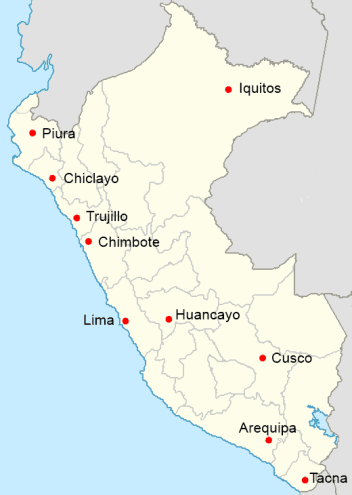
- The 10 Largest Cities in Peru by Population
ENTERTAINMENT TIP: If looking for fun at night, or to watch sports during the day, or even a taste of home, visit the Wild Rover Hostels Chain for great food, sports and beer! Entrance to their bars is free even for non-guests
Top 5 Cities in Peru: In-Depth Guide
1. Lima
Population: Approximately 11.5 million (2025 estimate, metropolitan area)
If you’re heading to Peru, Lima is likely the first city on your list. As the country’s capital and largest city, Lima is where the modern and historical blend seamlessly. Founded in 1535 by Spanish conquistador Francisco Pizarro, this city was once known as the “City of Kings” and was the center of Spain’s vast empire in South America. Today, it still retains that regal air, offering a fascinating mix of colonial charm and modern development, all set against the backdrop of the Pacific Ocean.
Lima is unique as the only South American capital located directly on the coast, meaning you can enjoy stunning ocean views while exploring a city steeped in history. As you stroll through the historic center, which is a UNESCO World Heritage site, you’ll be captivated by the impressive colonial architecture, including the Government Palace, the Cathedral of Lima, and several grand churches and mansions.
The city’s neighborhoods each have something different to offer. If you’re looking for lively vibes and cultural experiences, Miraflores and Barranco will capture your attention. Here, you’ll find picturesque coastal walks, upscale shopping, vibrant art galleries, and a nightlife scene that’ll keep you entertained long into the night. San Isidro is the city’s financial hub, filled with sleek skyscrapers, while Lima Centro offers a deep dive into the city’s colonial history.
Must-See Attractions:
- Plaza Mayor (Plaza de Armas): The historical center of the city, surrounded by breathtaking colonial architecture.
- Huaca Pucllana: A pre-Incan adobe pyramid right in the middle of Miraflores, offering a glimpse into Peru’s ancient past.
- The Larco Museum: Home to a remarkable collection of pre-Columbian art, perfect for history lovers.
- The Malecón: A scenic six-mile clifftop walkway with stunning views of the Pacific Ocean.
- Larcomar: A modern shopping complex perched on the cliffs, where you can shop, dine, and enjoy the breathtaking oceanfront views.
And if you love food, Lima won’t disappoint. The city has earned a global reputation for its culinary scene, with world-class restaurants like Central and Maido consistently ranked among the best in the world. Be sure to try local favorites like ceviche, lomo saltado, and of course, the famous pisco sour.
Lima offers a perfect starting point for your adventure in Peru—whether you’re looking to soak in history, explore the modern city, or indulge in some of the best food you’ll ever taste.
2. Cusco
Population: Approximately 513,000 (2025 estimate)
Cusco is where history comes to life. Often referred to as the “Archaeological Capital of the Americas,” this UNESCO World Heritage city holds deep cultural and historical significance. Once the heart of the mighty Incan Empire, Cusco sits at a breathtaking 3,400 meters (11,200 feet) in the Andes Mountains. Founded around 1100 CE and reshaped in the 15th century by Incan ruler Pachacuti, it became the center of Incan power until the Spanish conquest in 1533. The name “Cusco” comes from the Quechua word “Qosqo,” meaning “navel” or “center of the world,” reflecting its vital role in Incan cosmology.
Today, Cusco is the gateway to Machu Picchu and a city in its own right that’s brimming with life, history, and unmatched beauty. The city blends Incan and Spanish colonial architecture, with many structures resting on the original Incan stone foundations.
As you explore the historic center, you’ll notice the remarkable stonework, some of the most perfect masonry in the world.
Must-See Attractions:
- Plaza de Armas: The central square is surrounded by colonial arcades and churches, offering a lively spot to soak in the atmosphere.
- Qorikancha (Temple of the Sun): Once the most important Incan temple, now partially incorporated into the Church of Santo Domingo, it’s a must-see for history buffs.
- Sacsayhuamán: These massive Incan fortress ruins, perched high above the city, offer panoramic views and a glimpse into Cusco’s ancient power.
- San Pedro Market: This vibrant local market is a sensory delight, selling everything from fresh produce to textiles and handicrafts.
- San Blas District: Known for its narrow streets, this bohemian area is filled with artisan workshops, galleries, and charming cafes.
While Cusco itself is a must-visit destination, it also serves as the perfect base to explore the Sacred Valley of the Incas and, of course, the world-famous Machu Picchu. The city has adapted well to tourism, offering accommodations ranging from budget-friendly hostels to luxurious hotels housed in beautifully restored colonial mansions. Keep in mind the city’s high altitude, so it’s important to acclimatize before diving into any strenuous activities.
Cusco isn’t just a stop on your way to Machu Picchu; it’s a journey into the past, offering a perfect balance of ancient wonders and modern-day charm.
3. Arequipa
Population: Approximately 984,000 (2025 estimate, metropolitan area)
Arequipa, known as the “White City,” is one of Peru’s most visually stunning cities, famous for its architecture made from sillar, a white volcanic stone. As Peru’s second-largest city, Arequipa sits at 2,335 meters above sea level and is beautifully surrounded by three towering volcanoes: El Misti, Chachani, and Pichu Pichu.
Its striking landscape and unique blend of colonial charm and natural beauty make it a must-visit destination.
Founded in 1540, Arequipa boasts a historic center that earned UNESCO World Heritage status in 2000. The city is a remarkable fusion of European, indigenous, and mestizo influences, creating an outstanding architectural style. Arequipa’s residents, known as Arequipeños, are fiercely proud of their regional identity, often considering themselves Arequipeños before Peruvians.
The city’s pleasant climate—sunny and dry throughout the year—has earned it the nickname “City of Eternal Spring.” This favorable weather, combined with fertile volcanic soil in the surrounding areas, has helped Arequipa develop a reputation for delicious cuisine that attracts food lovers from across the globe.
Must-See Attractions:
- Santa Catalina Monastery: A vast 16th-century religious complex covering over 20,000 square meters, full of colorful streets and historic buildings.
- Plaza de Armas: This main square is one of the most beautiful in Peru, dominated by the stunning Cathedral of Arequipa.
- Yanahuara Viewpoint: A great spot to catch panoramic views of the city and the imposing El Misti volcano.
- San Camilo Market: A vibrant local market where you can experience the bustling heart of Arequipa, from fresh produce to street food.
- Museo Santuarios Andinos: Home to the famous “Juanita” ice mummy, this museum is a must-see for those interested in the region’s pre-Columbian history.
Arequipa is also a gateway to some of Peru’s most awe-inspiring natural wonders. One of the highlights is the Colca Canyon, which is twice as deep as the Grand Canyon and a fantastic spot for trekking and spotting Andean condors.
Arequipa is also a foodie’s paradise. Dishes like rocoto relleno (stuffed spicy peppers) and chupe de camarones (shrimp chowder) are local specialties that showcase the city’s unique culinary identity. Whether you’re exploring its historical landmarks or savoring the flavors of Arequipa’s cuisine, this city promises an unforgettable experience.
4. Trujillo
Population: Approximately 929,000 (2025 estimate, metropolitan area)
Trujillo, Peru’s third-largest city, is a captivating blend of history, culture, and archaeological wonder. Founded in 1534 by Spanish conquistador Diego de Almagro, this vibrant city serves as the capital of the La Libertad region in northern Peru. Trujillo is often called the “City of Eternal Spring,” thanks to its pleasant climate throughout the year. But it’s not just the weather that makes this city stand out; Trujillo is rich in colonial charm and ancient history.
Named after Francisco Pizarro’s birthplace in Spain, Trujillo holds a special place in Peru’s struggle for independence. In 1820, it became the first Peruvian city to declare independence from Spain, earning the title “Capital of Peruvian Independence.” Its historic center is adorned with beautifully preserved colonial buildings featuring colorful facades, wrought-iron balconies, and tranquil inner courtyards, offering a picturesque stroll through the past.
The surrounding area is a treasure trove of archaeological sites from the Moche and Chimú cultures, making Trujillo a top destination for history enthusiasts.
Must-See Attractions:
- Plaza de Armas: The central square is surrounded by impressive colonial buildings, including the Cathedral of Trujillo, showcasing the city’s historical significance.
- Chan Chan: This vast pre-Columbian city was once the capital of the Chimú Empire and is the largest mud-brick city in South America, offering a fascinating glimpse into ancient urban life.
- Huacas del Sol y de la Luna (Temples of the Sun and Moon): These Moche pyramid complexes are some of the most striking archaeological sites in Peru, known for their intricate murals and monumental structures.
- El Brujo Archaeological Complex: This site is home to significant Moche artifacts and murals, including the famous “Lady of Cao,” a mummified Moche ruler.
- Huanchaco Beach: Known for its traditional reed fishing boats, or “caballitos de totora,” this beach is perfect for a relaxing day by the sea.
Trujillo is also the birthplace of the marinera, a traditional Peruvian dance that is celebrated annually during the National Marinera Contest each January. Beyond its rich cultural scene, the city is a food lover’s haven, with northern Peruvian dishes like shambar (a hearty bean soup) and ceviche, known for its freshness and flavor, especially along Peru’s northern coast.
Whether exploring ancient ruins, enjoying a vibrant cultural scene, or indulging in the local cuisine, Trujillo offers a unique and enriching experience that captures the essence of northern Peru.
5. Iquitos
Population: Approximately 505,000 (2025 estimate)
Iquitos is unlike any other city in Peru. As the largest city in the Peruvian Amazon, it is the world’s largest city that cannot be reached by road—only accessible by air or river. Located at the confluence of the Amazon, Nanay, and Itaya rivers in northeastern Peru, Iquitos is a unique gateway into one of the most biodiverse regions on Earth.
Founded in the mid-19th century during the rubber boom, the city saw explosive growth and attracted fortune seekers from across the globe. This period left behind an impressive architectural legacy, with grand European-style mansions, including the famous Iron House, designed by Gustave Eiffel. The influence of this booming era is still visible in the city’s eclectic mix of colonial and industrial-era buildings.
Today, Iquitos serves as the jumping-off point for Amazonian adventures. The city itself is a vibrant, bustling hub where motorized tricycles (mototaxis) zip through streets that gradually fade into jungle paths. It’s a place where nature and culture blend seamlessly, offering a truly unique experience for visitors.
Must-See Attractions:
- The Malecón Tarapacá: This riverside promenade offers picturesque views of the Amazon River and is lined with historic buildings, giving you a glimpse into the city’s past.
- The Iron House (Casa de Fierro): Designed by Gustave Eiffel, this prefabricated building is a testament to Iquitos’ unique history during the rubber boom.
- Belén Market and Neighborhood: Known as the “Venice of the Amazon,” this floating community is an incredible place to explore, where houses and shops sit on stilts above the river.
- The Manatee Rescue Center: Visit this wildlife rehabilitation center to see efforts to protect endangered species like the Amazonian manatee.
- Plaza de Armas: This central square is decorated with a beautiful tile mosaic featuring Amazonian flora and fauna, a striking visual representation of the region’s biodiversity.
Iquitos is not just a city—it’s an adventure. It serves as the base for jungle expeditions, river cruises and stays at eco-lodges nestled in surrounding rainforest reserves such as Pacaya-Samiria and Allpahuayo-Mishana.
While here, you’ll also have the chance to learn about the indigenous Amazonian communities and their deep knowledge of medicinal plants and traditional practices, adding a cultural layer to your Amazonian exploration.
Whether you’re wandering through the bustling market, exploring the mighty Amazon River, or learning from the Indigenous communities, Iquitos is a city that feels like an entrance to another world—a place where nature and culture coexist in harmony.
Popular Cities in Peru by Foreign Visitors
The following table lists the 12 most visited cities in Peru by foreign tourists according to the BADATUR Peru tourism database. Of the 12 cities, six feature in the list of the 10 largest cities in Peru by population (see map above). For foreign visitors, the city itself isn’t always the main draw: individual tourist attractions located within or near the city are often of greater importance.
|
RANK |
CITY | PRIMARY REASINS FOR VISITING |
|
1 |
Lima |
Capital city, transport hub, numerous attractions, world-class cuisine, museums, colonial architecture |
|
2 |
Cusco |
Former Inca capital, gateway to Machu Picchu, numerous archaeological sites, vibrant cultural scene |
|
3 |
Puno |
Cultural hub, access to Lake Titicaca and floating reed islands, indigenous culture |
|
4 |
Arequipa |
Colonial “White City,” nearby Colca Canyon, Santa Catalina Monastery, regional cuisine |
|
5 |
Ica |
Nazca Lines, sandboarding at Huacachina oasis, Pisco brandy production and tours |
|
6 |
Paracas |
Islas Ballestas (“Poor Man’s Galapagos”), Paracas National Reserve, marine wildlife |
|
7 |
Huaraz |
Huascarán National Park, Cordillera Blanca mountain range, world-class trekking and climbing |
|
8 |
Trujillo |
Historic city, Chan Chan archaeological site, Huacas del Sol y de la Luna, northern beaches |
|
9 |
Puerto Maldonado |
Gateway to southern Amazon, jungle tours and eco-lodges, biodiversity hotspot |
|
10 |
Chiclayo |
Sipán archaeological site, excellent nearby museums (Tumbas Reales, Brüning), northern cuisine |
|
11 |
Cajamarca |
Historic highland town, Inca baths, colonial churches, dairy products and cheese |
| 12 | Iquitos |
Northern Amazon gateway, jungle tours and lodges, river cruises, unique isolated city |
Peru’s six most popular cities are located in the southern half of the country (Lima and south of Lima). That’s no great surprise: the southern route is known as the Gringo Trail for good reason.
Peru’s Cities: Geographic Distribution
Peru is a country of striking geographic diversity, and its cities reflect this wide range of environments. From the coastal cities that greet you with sea breezes to the towering Andean peaks and lush Amazon jungle, each region offers a unique experience.
Here’s a breakdown of the three distinct geographical regions and the cities within them:
- Coastal Cities (Costa): Including Lima, Trujillo, and Chiclayo, these cities enjoy milder climates and easier access to beaches and marine activities. Many feature significant colonial architecture and serve as commercial or transport hubs.
- Andean Cities (Sierra): Cities like Cusco, Arequipa, and Cajamarca sit at high elevations in the Andes mountains. They typically feature a mix of pre-Columbian and colonial heritage, spectacular mountain landscapes, and strong indigenous cultural influences.
- Jungle Cities (Selva): Iquitos and Puerto Maldonado serve as gateways to the Amazon rainforest. These cities offer access to extraordinary biodiversity, river travel, and indigenous communities, with distinctive architecture adapted to tropical conditions.
This geographical diversity means travelers visiting multiple cities in Peru can experience dramatically different environments, cuisines, and cultural expressions within a single country.
Your Favourite Cities in Peru
Out of all the incredible cities in Peru, which ones do you love the most? Do you find yourself drawn to the vibrant history and stunning landscapes of popular cities like Cusco and Arequipa, or perhaps you have a soft spot for one of Peru’s lesser-known gems? Peru’s diverse cities have so much to offer, whether it’s the colonial charm of Trujillo, the jungle adventure in Iquitos, or something else entirely.
We’d love to hear what makes your favorite city in Peru special to you. Share your thoughts and experiences in the comments below.
And if you’re ready to plan your trip to your favorite cities in Peru, be sure to check out FindLocalTrips.com, a tour comparison website that offers detailed information and a variety of options for that unforgettable adventure.
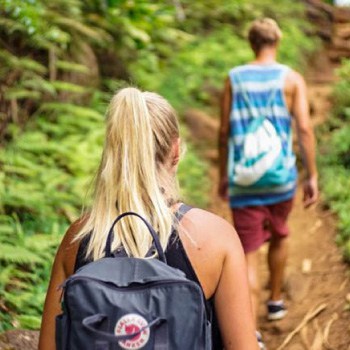
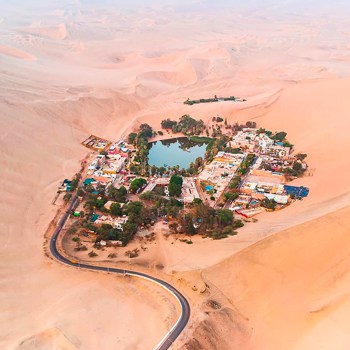
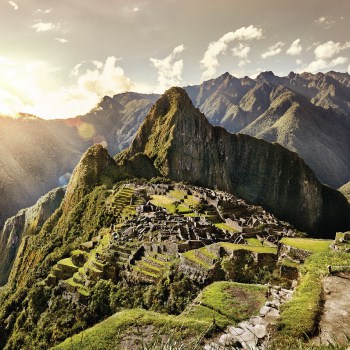
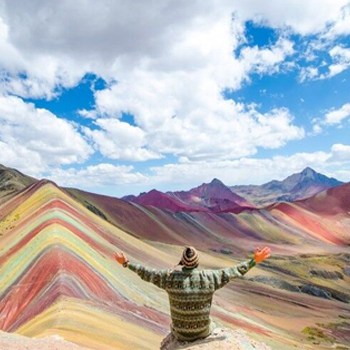


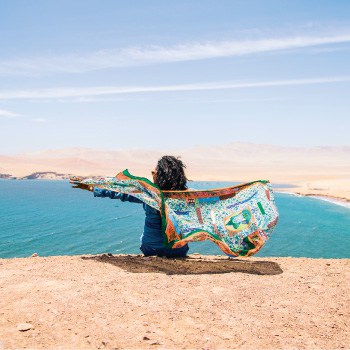
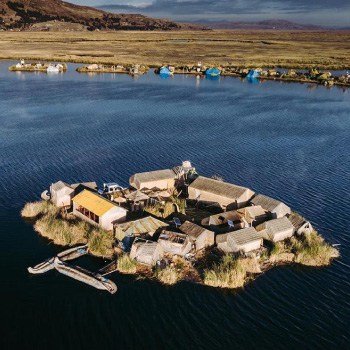
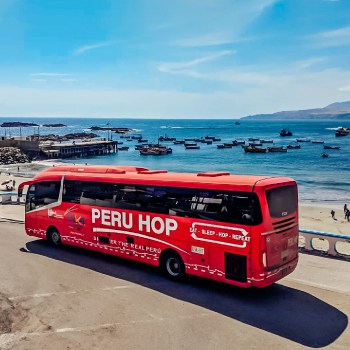
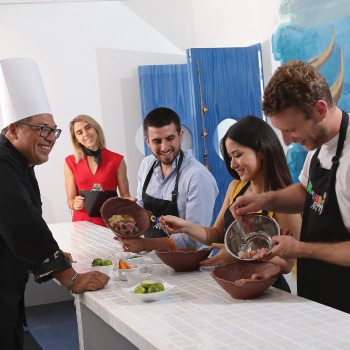
2 comments for “Cities in Peru You Must Visit: Lima, Cusco, Arequipa & More”